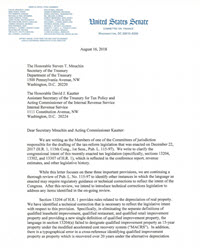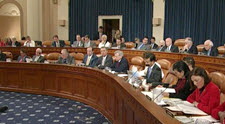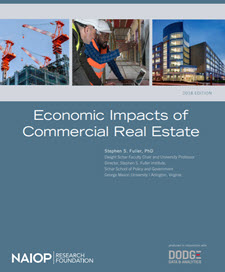Senate Finance Committee Republicans yesterday sent a letter to Treasury Secretary Steven Mnuchin and Acting IRS Commissioner David Kautter requesting clarifications to the tax overhaul legislation enacted last year – including guidance related to a drafting error that unintentionally pushed the cost recovery period for qualified property improvements (QIP) from 15 to 39 years. (The Hill, Aug. 16)
 |
|
The August 16 letter, signed by all Republican members of the Finance Committee and Chairman Orrin Hatch (R-UT), urges Treasury and the IRS to “issue guidance that is consistent with the congressional intent” of the new tax law regarding QIP expensing and two other tax policy areas. |
- The unintentional drafting mistake has resulted in a longer cost recovery period for qualified nonresidential interior improvements – a category that previously covered leasehold improvements, retail improvements, and new restaurant construction. (” Correcting the Drafting Error Involving the Expensing of Qualified Improvement Property” – The Tax Foundation, May 30)
- As a result of the mistake, businesses across the country are delaying, or significantly reducing, capital expenditures for building improvements, undermining job creation and economic activity.
- The August 16 letter, signed by all Republican members of the Finance Committee and Chairman Orrin Hatch (R-UT), urges Treasury and the IRS to “issue guidance that is consistent with the congressional intent” of the new tax law regarding QIP expensing and two other tax policy areas.
- On the depreciation of real property, the letter notes: “[I]n eliminating the separate definitions of qualified leasehold improvement, qualified restaurant, and qualified retail improvement property and providing a new single definition of qualified improvement property, the language…failed to designate qualified improvement property as 15-year property under the modified accelerated cost recovery system (“MACRS”). In addition, there is a typographical error in a cross-reference identifying qualified improvement property as property which is recovered over 20 years under the alternative depreciation system (“ADS”). Congressional intent was to provide a 15-year MACRS recovery period and a 20-year ADS recovery period for qualified improvement property. Such intent is set forth in the Conference Report to accompany (the Tax Cuts and Jobs Act ).” ( H.R. Rep. 115-466, at p. 366).”
- During a February hearing in the House, Treasury Secretary Mnuchin testified about the QIP issue: “I am aware of the error and it obviously was unintended. We are looking at whether there is anything we can do with regulations. I think it is likely that this is something that may need to be fixed in the bill. We look forward to working with you.” (Ways and Means Committee – Mnuchin’s testimony and hearing video and Roundtable Weekly, June 1)
- The letter, signed by Senate Finance Committee Chairman Orrin Hatch (R-UT) and other GOP tax writers, states they will also introduce legislation to correct unintentional mistakes in the new tax, although support from Democrats would be needed to pass such a bill. An amendment (# 3597) introduced July 26 by Sen. Pat Toomey (R-PA) to an appropriations bill (H.R. 6147) would have corrected the QIP drafting error, but did not receive a vote.
The letter also notes that the Finance Committee continues to review the law for potential areas that may require regulatory guidance or technical corrections: “After this review, we intend to introduce technical corrections legislation to address any items identified.” (Senate Finance Committee News Release, Aug. 16)



